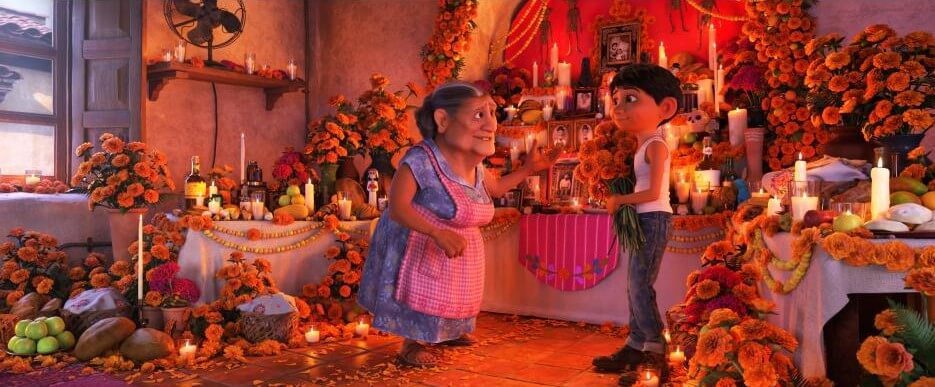On paper, Coco sounds destined for mediocrity. It’s another Disney/Pixar jam that tells the tired story of a young boy going on a (hero’s) journey to discover the importance of family. As a theme, „family“ is about as vanilla as it gets. But Coco’s unique, culturally specific version of what that means–what family is, the realistic and complex issues any family has, and a heavy emphasis on death and what it means to be remembered once you’re gone–go way past what you’d expect.
Coco follows Miguel, a young boy whose dream is to go against his family’s wishes and become a famous musician. The Rivera family has hated all music and musicians ever since Miguel’s nameless, faceless great-great-grandfather abandoned his wife and daughter–Miguel’s great-grandmother, Mama Coco–for a life on the road with his guitar. Miguel plays in secret, but a discovery about his ancestor’s identity spurs him to profess his love of music, to his family’s horror. He eventually makes his way to the Land of the Dead, Coco’s unique vision of the afterlife, and seeks his great-great-grandfather’s blessing.
Don’t let Coco’s sugary exterior fool you. Yes, it’s a visual feast, Pixar’s aesthetic at its absolute best. You’ll be mesmerized by the way the dog Dante’s tongue flops around, Abuelita’s arm fat jiggles as she smacks mariachis with her sandals, and millions of gleaming marigold petals swirl and drift through the air. Coco’s picturesque image of Mexican culture is alluring and fantastical, while still feeling true to life. And the same goes for its original songs, catchy, memorable riffs on familiar Mexican musical styles that you’re likely to find yourself whistling days after you leave the theater.
But Coco’s core is filled with real fears and raw emotions. The film poses questions that can elicit a sort of primal response, uncertainties about death and legacy welling up deep in your chest as you watch. It all ties into the Dia de los Muertos–the Day of the Dead–a Mexican holiday during which dead loved ones are said to visit their living families. Coco deftly bakes it all together, the visuals, music, characters, surprisingly twisty story, and themes forming a near-perfect meal–one that makes you weep or laugh with every bite.
The voice talent, an all-Latino cast, is exceptional, particularly Miguel’s Anthony Gonzalez, a newcomer who completely steals the show every time he opens his mouth to speak or sing. The songs really are fantastic, ranging from the playful, like „Un Poco Loco,“ to the gut-wrenching „Remember Me,“ which plays creatively into all Coco’s big themes.
Coco’s Land of the Dead is breathtaking to see, and the film does an impressive job establishing all its rules without getting bogged down in its own mythology. When you die, you wind up with pretty much the same job in the afterlife. So Miguel’s musical idol is an even bigger star, his family all make shoes still, and Frida Kahlo–who plays a surprisingly large and funny role–is an esoteric but iconic artist.
Coco establishes early on that your dead relatives can only visit once a year, on Dia de los Muertos, and only if you’ve put their picture on the ofrenda, a special shrine Mexican families erect for the holiday. No picture, no visit–you’re stuck in the Land of the Dead while everyone else gets to cross the marigold bridges and check in with their descendants. Later in the movie, it adds another wrinkle: If too many years go by like that, your life and deeds forgotten by the living, you disappear even from the afterlife.

That gives concrete meaning to the importance of being remembered when you’re gone. It makes Miguel’s struggles with his family–living and dead–into more than a story about a young boy rebelling. It creates stakes that viewers of any age can relate to. Young kids might find it hard to wrap their heads around, but nobody wants to be forgotten. And the way Coco weaves this all together, never getting too heady, but always keeping these stakes in the forefront while Miguel goes on his adventure, is actually awe-inspiring.
Coco is beautiful, hilarious, deeply touching, and emotional in a raw, powerful way that few movies–even Pixar movies–are able to capture. It’s all wrapped in the comforting confection of a memorable score, stunning animation and art direction, and a legitimately compelling story. But at its heart, Coco taps into some real primal stuff. Just be prepared for the strong urge you’ll feel to call your closest living family members when it’s over.
| The Good | The Bad |
|---|---|
| Lovely portrayal of Mexican culture | |
| Visually stunning | |
| Wonderful, catchy original songs | |
| Deep, raw thematic complexity |
Website: LINK


